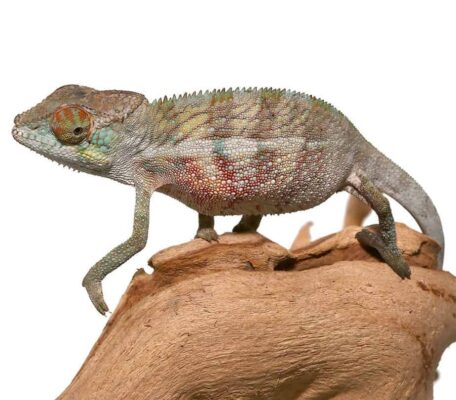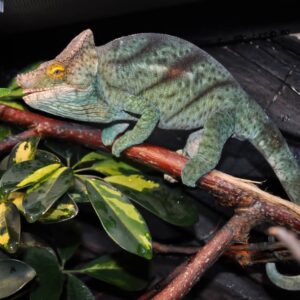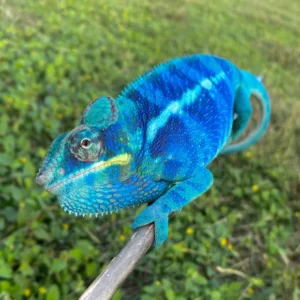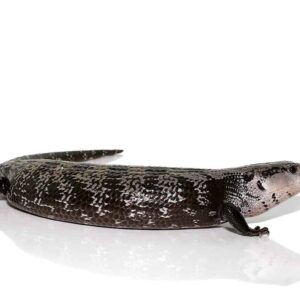Panther Chameleon For Sale
$299.99
WE HAVE JUVENILE PANTHER CHAMELEON FOR SALE. HERE ARE SOME HIGHLIGHTS:
- Furcifer pardalis
- Captive Bred
- Approximate Sizes Ranging From 6 – 8 Inches Length
- Adults Are Averaging Around 13 – 18 Inches In Total Length
- As Adults, These Will Develop Bright Reds, Blues, Greens, And Teal Colors!
- Feeding On Vitamin Dusted Crickets, Worms And Roaches
FUN FACTS!
- These Are Precision Hunters, Shooting Out Their Tongue At Lightning Speeds To Catch Prey
- Male Chameleons Display More Vibrant Colors Than Females
- Originating From Madagascar These Range From The Coast To Northeastern Madagascar
- Arboreal Species, Provide Plenty Of Fake Plants And Branches
- A Misting Or Dripping System For Water Is Best, Manual Misting Also Works
- With Proper Care They Can Live Up To 3 – 5+ Years In Captivity
Description
Panther Chameleon
The Panther Chameleon, scientifically known as Furcifer pardalis, is a remarkable reptile that captivates both scientists and enthusiasts alike. Commonly referred to as the Panther Chameleon, this species is a prominent member of the Chamaeleonidae family. Originating from the tropical forests of Madagascar, the Panther Chameleon is renowned for its vivid coloration and dynamic ability to change hues, making it one of the most visually stunning reptiles in the natural world.
What sets the Panther Chameleon apart is its unparalleled adaptability and vivid color spectrum. Unlike other chameleons that may exhibit more muted tones, the Panther Chameleon boasts an array of bright colors, including shades of red, green, blue, and orange. This vibrant display is not merely for show but serves various biological functions such as camouflage, communication, and temperature regulation.
Beyond its striking appearance, the Panther Chameleon exhibits several intriguing behaviors and physiological traits. For instance, it possesses a highly specialized tongue that can extend rapidly to capture prey, a characteristic feature of chameleons. Its eyes move independently, providing a panoramic view of its surroundings, which is crucial for spotting both predators and prey.
The Panther Chameleon’s ability to change color is not just a spectacle but a sophisticated process driven by various environmental factors and internal states. These include temperature, light, mood, and social interactions. This color-changing ability is facilitated by specialized cells called chromatophores, which contain different pigments that expand or contract to produce the desired color.
As we delve deeper into the world of the Panther Chameleon, it becomes evident that this species is not just a visual marvel but also a subject of extensive scientific interest. Its unique adaptations and behaviors offer valuable insights into the complexities of reptilian biology and ecology. The following sections will explore these aspects in greater detail, shedding light on the life of one of nature’s most fascinating creatures.
The Panther Chameleon (Furcifer pardalis) is predominantly native to the island of Madagascar, where it occupies a diverse range of ecosystems. This vibrant reptile is mainly found along the eastern and northern coastlines of the island, thriving in both rainforests and more arid regions. The chameleon’s adaptation to various environments underscores its remarkable versatility and resilience.
In the lush rainforests of Madagascar, Panther Chameleons inhabit the dense foliage, utilizing the abundant vegetation for both camouflage and hunting grounds. These rainforests provide a humid and sheltered environment that is ideal for the chameleon’s needs. The complex canopy structure offers numerous perches and hiding spots, allowing the chameleon to effectively regulate its body temperature and avoid predators.
In addition to rainforests, Panther Chameleons are also found in drier, coastal forests and scrublands. These areas, characterized by lower humidity and more sparse vegetation, present a stark contrast to the dense rainforests. Nevertheless, Panther Chameleons have adapted well to these conditions, demonstrating a remarkable ability to thrive in varied habitats. The adaptability of this species is a testament to its evolutionary success and ecological significance.
Notably, different populations of Panther Chameleons exhibit slight variations in coloration and patterns, which are often influenced by their specific habitats. These variations can be attributed to the distinct environmental conditions and selective pressures present in different regions of Madagascar. For instance, chameleons from the northern parts of the island tend to display more vibrant and diverse colorations compared to those from the eastern regions.
Overall, the Panther Chameleon’s distribution across Madagascar highlights its adaptability and ecological diversity. By thriving in a range of environments, from humid rainforests to arid coastal areas, the Panther Chameleon exemplifies the dynamic relationship between species and their habitats.
Physical Characteristics and Coloration
The Panther Chameleon, scientifically known as Furcifer pardalis, is renowned for its remarkable ability to display an array of vibrant colors. This ability is not merely for aesthetic appeal; it serves crucial functions in communication, camouflage, and thermoregulation. The chameleon’s skin contains specialized cells called chromatophores, which house various pigments capable of reflecting different wavelengths of light. By expanding or contracting these cells, Panther Chameleons can produce a wide spectrum of colors.
One of the most striking features of the Panther Chameleon is the sexual dimorphism exhibited in their coloration. Males generally boast a more vivid and varied color palette compared to females. While males can showcase hues ranging from bright reds and blues to greens and yellows, females typically exhibit more subdued shades of peach, pink, and brown. This differentiation in coloration is not just a visual treat but also plays a role in mating rituals and territorial disputes.
Coloration among Panther Chameleons also varies significantly based on their geographic locale. For instance, chameleons from the Ambilobe region are known for their striking red and blue patterns, while those from Nosy Be exhibit predominantly blue shades. These regional variations are so distinctive that they often serve as a reliable indicator of the chameleon’s origin.
The ability to change color is also an essential aspect of the Panther Chameleon’s survival strategy. This color shift can be triggered by various factors such as temperature, mood, or the presence of rivals or potential mates. For instance, darker colors may be adopted to absorb more heat when the chameleon is cold, while brighter colors are often displayed during courtship or when asserting dominance. Conversely, blending into the environment helps them evade predators, making color change a multifaceted tool that enhances their adaptability and survival.
Diet and Hunting Behavior
The Panther Chameleon, a stunning reptile native to the forests of Madagascar, has a diet primarily composed of insects. In the wild, these chameleons exhibit fascinating hunting behaviors that highlight their adaptability and unique physiological traits. Their primary food sources include a variety of insects such as crickets, grasshoppers, and beetles, which provide the necessary nutrients for their survival and growth.
One of the most remarkable hunting techniques of the Panther Chameleon is its use of a projectile tongue. This specialized tongue can extend up to twice the length of the chameleon’s body, allowing it to capture prey from a significant distance. The tongue’s rapid extension and retraction are powered by a combination of muscular and elastic elements, making it one of the fastest movements in the animal kingdom. This adaptation is particularly advantageous in the dense foliage of their natural habitat, where stealth and precision are crucial for successful hunting.
In captivity, the diet of Panther Chameleons can be slightly different from their wild counterparts. While insects remain the primary food source, captive chameleons may also be fed commercially available insect feeders such as mealworms, roaches, and waxworms. It is essential for keepers to provide a varied diet to ensure the chameleons receive a balanced intake of nutrients. Additionally, supplementing their diet with calcium and vitamin D3 is crucial to prevent common health issues such as metabolic bone disease.
Overall, the dietary habits and hunting behavior of the Panther Chameleon are a testament to their evolutionary adaptations. Whether in the wild or in captivity, these reptiles showcase remarkable skills that enable them to thrive in their respective environments. Their diet, dominated by insects and characterized by their impressive hunting techniques, reflects their role as effective predators in the ecosystem.
Reproduction and Lifespan
The reproductive behaviors of the Panther Chameleon are as captivating as their vibrant coloration. During the mating season, male Panther Chameleons exhibit intensified hues and engage in displays of dominance to attract females. These displays often include head-bobbing and color changes to demonstrate their suitability as mates. Once a female is receptive, the mating process is relatively brief, typically lasting only a few minutes.
Post-mating, the female Panther Chameleon undergoes a gestation period of approximately 20 to 30 days. After this period, she seeks a suitable location to lay her eggs, favoring soft, moist soil where she can dig a burrow. The female usually lays between 10 to 40 eggs, depending on her age and health. Once the eggs are deposited, she covers them with soil to protect them from predators and environmental hazards.
The eggs of Panther Chameleons incubate for an extended period, ranging from six to twelve months, depending on environmental conditions such as temperature and humidity. Upon hatching, the juvenile chameleons are independent and receive no parental care. They are small replicas of their adult counterparts, already equipped with the instinctual behaviors needed for survival.
In the wild, the lifespan of a Panther Chameleon can be influenced by various factors, including predation, environmental conditions, and availability of food. On average, they live between three to five years. However, in captivity, where threats are minimized, and optimal care is provided, Panther Chameleons can live up to seven years or more. The controlled environment of captivity allows for better management of their diet, health, and habitat, contributing to their extended lifespan.
Understanding the reproductive cycle and lifespan of Panther Chameleons not only enhances our knowledge of these remarkable reptiles but also underscores the importance of providing appropriate care and conservation efforts to ensure their survival both in the wild and in captivity.
Behavior and Temperament
The Panther Chameleon, a species renowned for its vivid coloration and dynamic display, exhibits a range of fascinating behaviors and temperamental characteristics. Primarily solitary creatures, Panther Chameleons are highly territorial, especially males who often engage in visual displays to assert dominance and ward off rivals. These displays include color changes and body posturing, which are both captivating and indicative of their complex social interactions.
Daily activity patterns of Panther Chameleons are predominantly diurnal, meaning they are active during the day and rest at night. During the daylight hours, they engage in foraging for insects, basking under sunlight to regulate their body temperature, and exploring their environment. Their movement is characteristically slow and deliberate, complemented by their unique zygodactylous feet, which provide a strong grip on branches, enhancing their arboreal lifestyle.
When faced with potential threats, Panther Chameleons exhibit a range of defensive behaviors. They may change color to blend into their surroundings, puff up their bodies to appear larger, or hiss to deter predators. This adaptability not only serves as a survival mechanism but also underscores their complex communication methods.
Considering their temperament, Panther Chameleons are generally not considered social animals and prefer to live alone. This solitary nature extends to their interactions with humans, where they may exhibit stress if handled excessively. Thus, they are best suited for pet owners who appreciate observing their behavior from a distance rather than direct interaction.
Special care requirements for Panther Chameleons include maintaining appropriate temperature gradients, providing ample climbing structures, and ensuring a diet rich in live insects. Additionally, their enclosures must mimic their natural habitat with proper humidity levels and foliage to facilitate their arboreal activities. Understanding these needs is crucial for anyone considering them as pets, ensuring their well-being and longevity in captivity.
Conservation Status and Threats
The Panther Chameleon (Furcifer pardalis) is a remarkable species native to Madagascar, known for its vibrant colors and unique ability to change hues. Despite their captivating beauty, Panther Chameleons face several threats that have led to concerns about their conservation status. Currently, the species is listed as “Least Concern” by the International Union for Conservation of Nature (IUCN). However, this status does not imply that the Panther Chameleon is free from threats.
One of the primary dangers to Panther Chameleons is habitat destruction. Madagascar’s forests, which serve as the natural habitat for these chameleons, are being rapidly depleted due to deforestation for agriculture, logging, and human settlement expansion. This loss of habitat reduces the available space for Panther Chameleons to live and breed, significantly impacting their populations in the wild.
Climate change further exacerbates the challenges faced by Panther Chameleons. Changes in temperature and weather patterns can alter their habitat conditions, affecting their ability to find food, reproduce, and survive. These environmental shifts can lead to a decline in chameleon populations if they are unable to adapt quickly enough to the changing conditions.
The pet trade poses another significant threat. Panther Chameleons are highly sought after for their striking appearance, leading to extensive capturing and exporting of these animals from Madagascar. While some of this trade is regulated, illegal and unregulated trade still persists, contributing to population declines in the wild. The removal of individuals from their natural habitat disrupts local ecosystems and reduces genetic diversity, making the species more vulnerable to extinction.
To combat these threats, various conservation efforts are underway. Madagascar has established protected areas to conserve critical habitats and limit deforestation. Additionally, international regulations, such as the Convention on International Trade in Endangered Species of Wild Fauna and Flora (CITES), aim to control and monitor the trade of Panther Chameleons to ensure it is sustainable and legal. Conservation organizations also work on raising awareness and educating local communities about the importance of preserving this unique species.
Through a combination of habitat protection, climate change mitigation, and strict regulation of the pet trade, there is hope for the continued survival of the Panther Chameleon in the wild. Ensuring the future of this extraordinary species requires ongoing commitment and collaboration from governments, conservationists, and the global community.
Conclusion and Fun Facts
The Panther Chameleon stands out as one of the most captivating reptiles in the animal kingdom. Throughout this blog post, we have delved into the habitat, physical characteristics, diet, and unique behaviors of this remarkable species. Not only do Panther Chameleons boast vibrant and varied color patterns, but they also exhibit fascinating adaptive traits such as their independently moving eyes and elongated, sticky tongues that facilitate efficient prey capture. These chameleons thrive in Madagascar’s diverse ecosystems, making them a vital part of the biodiversity in this region.
To leave you with a lasting impression, here are some fun and lesser-known facts about Panther Chameleons:
1. Each Panther Chameleon is like a living work of art, with males displaying a wide spectrum of colors influenced by their locality. These color variations can be so distinct that they are often used to identify the geographic origin of the chameleon.
2. Panther Chameleons possess a unique ability to see ultraviolet light, which plays a significant role in their communication and mating behaviors. This ultraviolet vision helps them detect subtle cues that are invisible to the human eye.
3. Contrary to popular belief, chameleons do not change color primarily for camouflage. Instead, their color changes are mainly driven by mood, temperature regulation, and communication with other chameleons.
4. The feet of Panther Chameleons are specially adapted for grasping, with each foot having five toes divided into two groups, enabling them to grasp branches firmly. This zygodactylous arrangement provides them with a strong grip that is essential for navigating their arboreal habitats.
5. Panther Chameleons have a remarkably slow and stealthy movement, which aids in their ability to approach prey without being detected. This deliberate movement also helps them avoid detection by predators.
By understanding and appreciating these mesmerizing reptiles, we can better recognize the importance of conserving their natural habitats and ensuring the survival of Panther Chameleons for future generations to marvel at and study.







